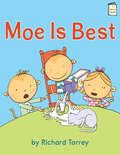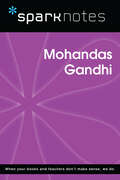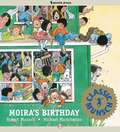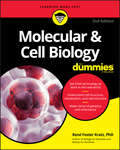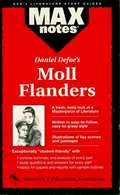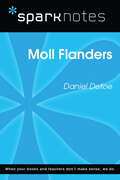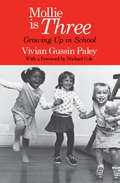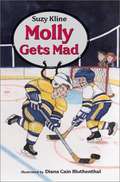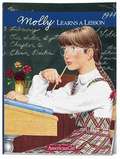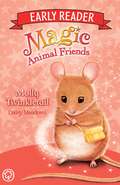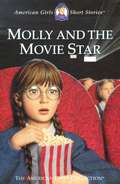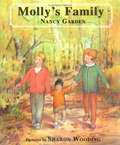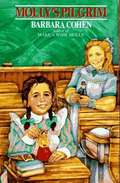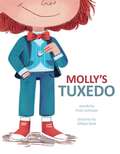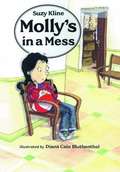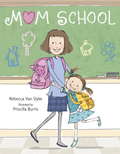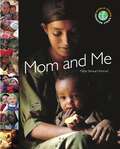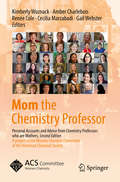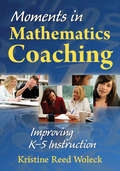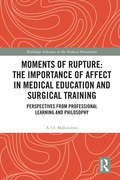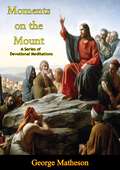- Table View
- List View
Moe Is Best (I Like to Read)
by Richard TorreyMoe is little, but he wants to be the best. He tries to prove his worth to his older siblings by showing off all the things he can do. Each feat turns out to be harder than expected, however, and Moe's brother and sister call attention to his many mistakes. He feels discouraged until his siblings point out that he is actually the best at one important thing: Moe is best at trying! With a satisfying ending and adorable monkey characters, Richard Torrey's story will inspire young readers to keep on trying. An I Like to Read(R) book. Guided Reading Level F.
Mohandas Gandhi (SparkNotes Biography Guide)
by SparkNotesMohandas Gandhi (SparkNotes Biography Guide) Making the reading experience fun! SparkNotes Biography Guides examine the lives of historical luminaries, from Alexander the Great to Virginia Woolf. Each biography guide includes:An examination of the historical context in which the person lived A summary of the person&’s life and achievements A glossary of important terms, people, and events An in-depth look at the key epochs in the person&’s career Study questions and essay topics A review test Suggestions for further reading Whether you&’re a student of history or just a student cramming for a history exam, SparkNotes Biography guides are a reliable, thorough, and readable resource.
Moira's Birthday
by Robert Munsch Michael MartchenkoMoira invites grades 1 to 6 to her party. But her parents don't know--until ...
Mokgadi o na le mosola
by Ruth Zitha Thembekile MsibiE ke tlhatlhamano ya dipadiso tse di itumedusang tse e leng motswedi o o tlhotlheletsang barutabana go ngokela le go rotloetsa baithuti mo phaposing. Buka nngwe le nngwe e tlhamilwe ka kelotlhoko e bile e siametse go tshegetsa baithuti ba e leng gona ba simololang go ithuta Setswana.
Molecular & Cell Biology For Dummies
by Rene Fester KratzYour insider guide to the stuff of life 3.8 billion years old and counting, there’s more than a little to know about the fundamentals of how life works. This friendly guide takes you from the primordial soup to the present, explaining how specialized cells have given rise to everything living, from the humblest amoeba to walking, talking human beings. Whether you’re enrolled in a cell or molecular biology course and need a straightforward overview, or are just curious about the latest advances, this fully updated edition is your all-access ticket to our inner world. Molecular & Cell Biology For Dummies decodes jargon and theories that can tax even the most devoted student. It covers everything from basic principles to how new technology, genetic testing, and microarray techniques are opening up new possibilities for research and careers. It also includes invaluable tips on how to prepare for—and ace—your exams! Explore the structure and function of the cells—and find out why cellular context is crucial to the study of disease Discover how molecular biology can solve world problems Understand how DNA determines traits and is regulated by cells Enhance your knowledge and results with online resources and study tips From microscopic details to macro concepts, this book has something for you.
Moll Flanders (MAXNotes Literature Guides)
by Susan GallagherREA's MAXnotes for Daniel Defoe's Moll Flanders MAXnotes offer a fresh look at masterpieces of literature, presented in a lively and interesting fashion. Written by literary experts who currently teach the subject, MAXnotes will enhance your understanding and enjoyment of the work. MAXnotes are designed to stimulate independent thought about the literary work by raising various issues and thought-provoking ideas and questions. MAXnotes cover the essentials of what one should know about each work, including an overall summary, character lists, an explanation and discussion of the plot, the work's historical context, illustrations to convey the mood of the work, and a biography of the author. Each chapter is individually summarized and analyzed, and has study questions and answers.
Moll Flanders (SparkNotes Literature Guide Series)
by SparkNotesMoll Flanders (SparkNotes Literature Guide) by Daniel Defoe Making the reading experience fun! Created by Harvard students for students everywhere, SparkNotes is a new breed of study guide: smarter, better, faster. Geared to what today's students need to know, SparkNotes provides: *Chapter-by-chapter analysis *Explanations of key themes, motifs, and symbols *A review quiz and essay topicsLively and accessible, these guides are perfect for late-night studying and writing papers
Mollie is Three: Growing Up in School
by Vivian Gussin Paley"No adult can escape the adult perspective; but simply recognizing its inevitable limitations in a children's world enables a few gifted educators to accept the existence and vilify of whole kindergartens full of different perspectives. One such person is Vivian Gussin Paley. . . . Her books. . . should be required reading wherever children are growing. "-New York Times Book Review "With a delightful, almost magical touch, Paley shares her observations and insights about three-year-olds. The use of a tape recorder in the classroom gives her a second chance to hear students' thoughts from the doll corner to the playground, and to reflect on the ways in which young children make sense of the experience of school. . . . Paley lets the children speak for themselves, and through their words we reenter the world of the child in all its fantasy and inventiveness. "-Harvard Educational Review "Paley's vivid and accurate descriptions depict both spontaneous and recurring incidents and outline increasingly complex interactions among the children. Included in the narrative are questions or ideas to challenge the reader to gain more insight and understanding into the motives and conceptualizations of Mollie and other children. "-Karen L. Peterson, Young Children
Molly Gets Mad
by Suzy KlineSurprise--Molly's in trouble again! Molly Zander and her best friend Morty get more surprises than they bargained for on their "surprise" class trip to the town's brand-new ice rink. Everyone tries to guess the secret destination, but when they get to the rink, Molly finds out she's not the only star athlete around anymore--she has some real competition in Florence, a talented figure skater. Though Molly risks her friendship with Morty by trying to be number one, in the end she decides that some things are more important than being the best.
Molly Learns A Lesson: A School Story (American Girls #2)
by Valerie TrippFrom the book: "When the teacher announces the Lend-a-Hand Contest to help the war effort, Molly is determined that the third grade girls will plan the winning project. Instead, they choose an idea that Molly knows will never work out. So she talks two friends into planning their own project and keeping it a secret from the rest of the girls in the class. But the secret project turns out to be harder than Molly thought it would be. She begins to worry that it might not win after all and decides to spy on the other girls to see how they are doing. When Molly and her friends get caught peeking in a window, they learn some important lessons."
Molly Twinkletail: Book 2 (Magic Animal Friends Early Reader #2)
by Daisy MeadowsThe much-loved series from the creator of Rainbow Magic - abridged for younger readers and illustrated in full colour!Welcome to a magical world where animals talk and play - just like you and me!Best friends Jess and Lily love all animals. But when they follow a mysterious golden cat into Friendship Forest - a place where animals live in tiny cottages and sip dandelion tea at the Toadstool Cafe - their animal friends suddenly become much more magical!On their second adventure, Lily and Jess are invited to the Friendship Forest fair! But Grizelda the witch wants to spoil everyone's fun and her servants, the Boggits, trick little Molly Twinkletail into running away from the party. It's up to the girls to find her - but where in Friendship Forest would a tiny mouse hide?
Molly and the Movie Star (American Girls Short Stories #12)
by Valerie TrippMolly is eager to meet a famous movie star at a War Bond rally, until she cannot find the money that her class had collected to buy a bond. Includes information on movies during World War II and a recipe for popcorn.
Molly's Family
by Nancy GardenWhen Tommy asserts that nobody can have more than one Mommy, Molly is confused. She and her classmates learn that some families have two daddies, some only have one, and some families don't have any daddies at all. This book provides a gentle way for parents to acquaint children with the different family structures which are commonplace in our society today.
Molly's Pilgrim
by Barbara CohenMolly and her family have moved to America from Russia. her mother says they moved to find freedom. But the children in Molly's third grade class make fun of her accent and clothes. that doesn't seem like freedom to Molly at all. At Thanksgiving everyone has to bring a Pilgrim doll to class. The doll Molly's mother makes looks like a russian peasant girl. It doesn't look at all like the Pilgrims Molly has seen in her schoolbook. Molly is afraid she'll never fit in with her classmates now.
Molly's Tuxedo
by Vicki JohnsonMolly wants to look her best for picture day at her school, and what looks better than a tux? <P><P> Molly's school picture day is coming up, and she wants to have a perfect portrait taken to hang on their wall. Her mom has picked out a nice dress for her, but Molly knows from experience that dresses are trouble. They have tight places and hard-to-reach zippers, and worst of all, no pockets! Luckily, she has the perfect thing to save picture day--her brother's old tuxedo! <P><P> But mom doesn't want her to wear a tuxedo in the photo; she thinks Molly looks best in the dress. Can Molly find the courage to follow her heart and get her mom to realize just how awesome she'd look in a tux? This book highlights a gender nonconforming main character and is published in partnership with GLAAD to accelerate LGBTQ inclusivity and acceptance. <P><P><i>Advisory: Bookshare has learned that this book offers only partial accessibility. We have kept it in the collection because it is useful for some of our members. Benetech is actively working on projects to improve accessibility issues such as these.</i>
Molly's in a Mess
by Suzy KlineMorty Hill worries that his best friend Molly Zander will get in trouble at school when a new classmate tells that Molly is the one who knocked off the principal's toupee.
Mom School
by Priscilla Burris Rebecca Van SlykeIn this adorable kid's-eye view of what would happen if Mom went to school, a little girl imagines Mom School, where all moms learn their amazing skills, like fixing a bike tire and baking cupcakes. With warm, funny illustrations and a fun role-reversal story in which moms act like kids, young readers will love imagining what would happen if their own moms went to Mom School.
Mom and Me (Early Reader #1)
by Marla Stewart KonradA picture book collaboration with World Vision that celebrates life the world over!Mom and Me is an affectionate look at the many ways mothers and children relate to and rely upon each other. When nourishment, assistance, instruction, comfort, and special hugs are needed, Mom can offer them in special ways that only their children will ever know. The deep bond they share is beautifully depicted in these storytelling images.This delightful series is the result of the collaboration between Tundra Books and World Vision Canada to bring an array of exceptional photos from around the world to very young children. Each book centers on a universal theme, familiar by its very nature, yet new due to faraway settings and ethnic, cultural, and socio-economic diversity. Each remarkable photo essay will foster discussion, observation, and many smiles as children compare and contrast their own experience to that of others. Watch for further books in this series.
Mom the Chemistry Professor: Personal Accounts and Advice from Chemistry Professors who are Mothers
by Renée Cole Cecilia Marzabadi Gail Webster Kimberly Woznack Amber CharleboisWhen is the "right" time? How can I meet the demands of a professorship whilst caring for a young family? Choosing to become a mother has a profound effect on the career path of women holding academic positions, especially in the physical sciences. Yet many women successfully manage to do both. In this second edition, which is a project of the Women Chemists Committee (WCC) of the American Chemical Society (ACS), 40 inspirational personal accounts describe the challenges and rewards of combining motherhood with an academic career in chemistry. The authors are all women at different stages of their career and from a range of institution types, in both tenure and non-tenure track positions. The authors include women from different racial and ethnic backgrounds, who became mothers at different stages of their career, and who have a variety of family structures. Aimed at undergraduate and graduate students of chemistry, as well as postdoctoral fellows and early career faculty, these contributions serve as examples for women considering a career in academia but worry about how this can be balanced with other important aspects of life. The authors describe how they overcame particular challenges, but also highlight aspects of the system, which could be improved to accommodate women academics, and particularly encourage more women to take on academic positions in the sciences.
Moments in Mathematics Coaching: Improving K–5 Instruction
by Kristine R. WoleckThe author unpacks specific cases or "moments" from her years as a mathematics coach, discussing what effective coaching looks like in practice, how to build relationships with teachers, and more.
Moments of Rupture: Perspectives from Professional Learning and Philosophy (Routledge Advances in the Medical Humanities)
by A. O. MahendranSurgery is a craft specialty: ‘doing’ in response to what is seen, felt and anticipated. The potent odours and the raw images of flesh, elicit strong sensations and responses in the here-and-now or ‘thisness’ (haecceities) of practice. These experiences, trigger a world of affects and senses that can disturb or rupture familiar or established ways of thinking and knowing. This book attempts to articulate these emotional complexities of learning and practice by exploring affective encounters with the uncertainty of medical events. Employing a practice based inquiry, grounded in philosophical notions of affect and related concepts, real stories of actual practice are analysed and theorised to examine how events of clinical practice come to matter or become meaningful to surgeons, potentially disclosing new or modified capacities to see, think, understand and act. The philosophical writings of Alfred North Whitehead, Gilles Deleuze, Gilbert Simondon and Brian Massumi inform the exploration. The critical discussions of this book are relevant for healthcare professionals, medical educators, practitioners and researchers interested in its main exploration: the affective conditions that emerge from disturbances in practice and their power to shape, construct and transform how professionals understand their practice and function within it.
Moments on the Mount: A Series of Devotional Meditations
by George MathesonTHERE are two motives which have influenced us in the production of this little book. We have sought, on the one hand, to supply aids to devotion either for the use of the family or of the individual, and on the other, to furnish points of suggestion to the student who is a prospective preacher. Perhaps it may be thought that these two aims are incongruous, and it would be too much to hope that in both we have succeeded; yet devotion is not the absence of thought, and thought is not necessarily the absence of devotion. At all events, the presence in the mind of two so reactionary aims may have had the beneficial result of preserving these meditations either from the fault of too much abstractness or from the sin of too little depth.IT is only in the cool of the day that I can hear Thy footsteps, O my God. Thou art ever walking in the garden. Thy presence is abroad everywhere and always; but it is not everywhere nor always that I can hear Thee passing by. The burden and heat of the day are too strong for me. The struggles of life excite me, the ambitions of life perturb me, the glitter of life dazzles me; it is all thunder and earthquake and fire. But when I myself am still I catch Thy still small voice, and then I know that Thou art God. Thy peace can only speak to my peacefulness, Thy rest can only be audible to my calm; the harmony of Thy tread cannot be heard by the discord of my soul. Therefore, betimes I would be alone with Thee, away from the heat and the battle. I would feel the cool breath of Thy Spirit, that I may be refreshed once more for the strife. I would be fanned by the breezes of heaven, that I may resume the dusty road and the dolorous way. Not to avoid them do I come to Thee, but that I may be able more perfectly to bear them. Let me hear Thy voice in the garden in the cool of the day.
